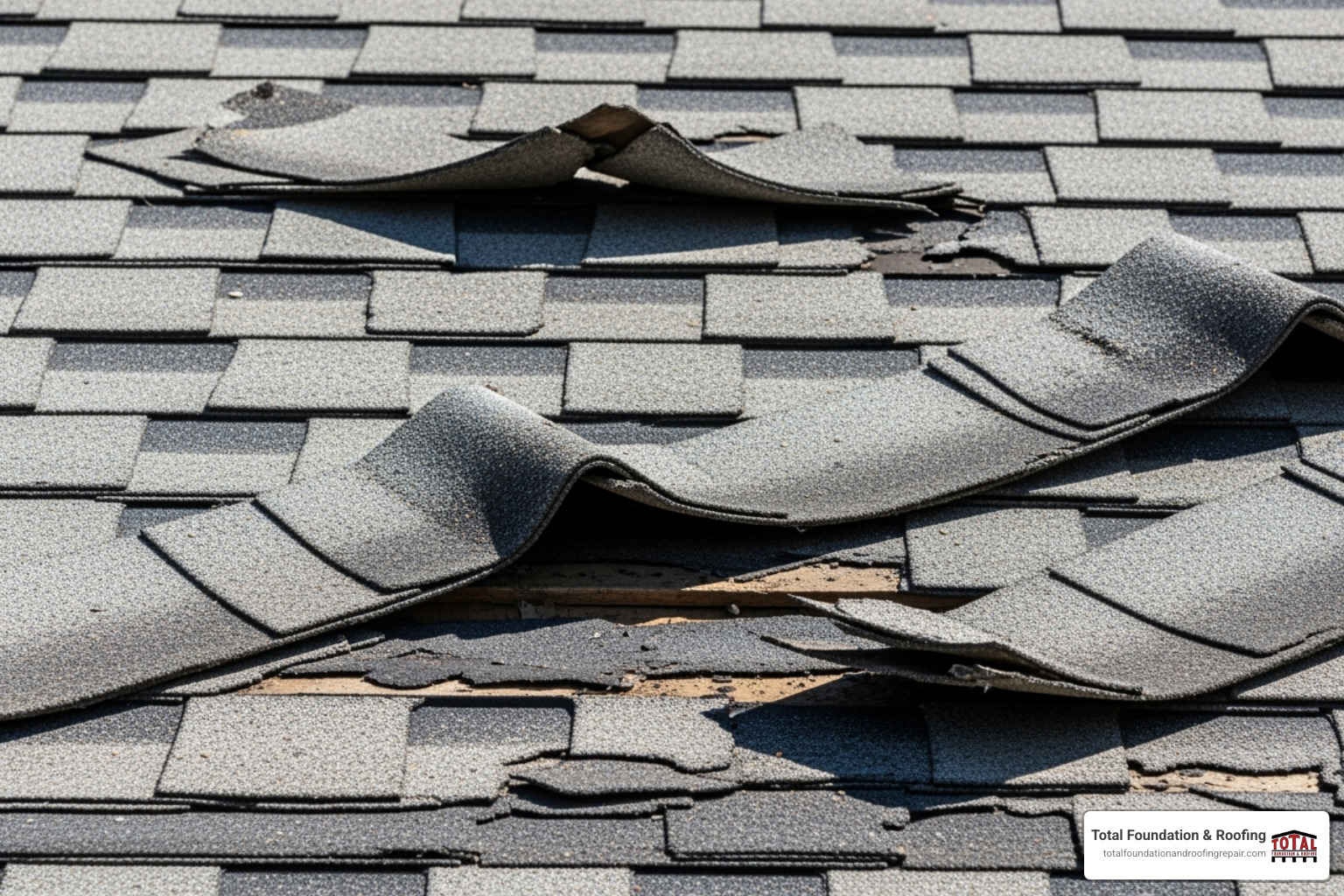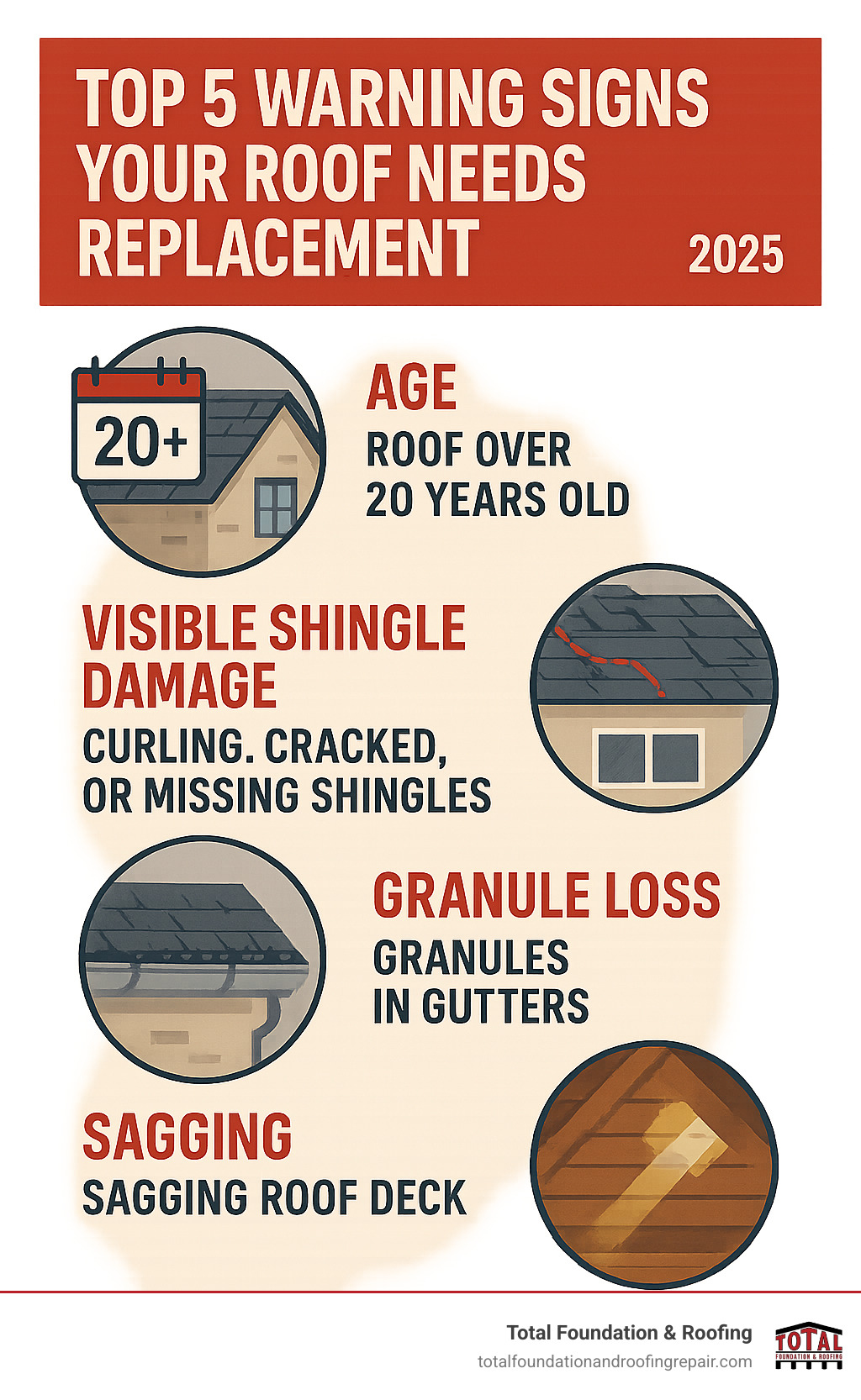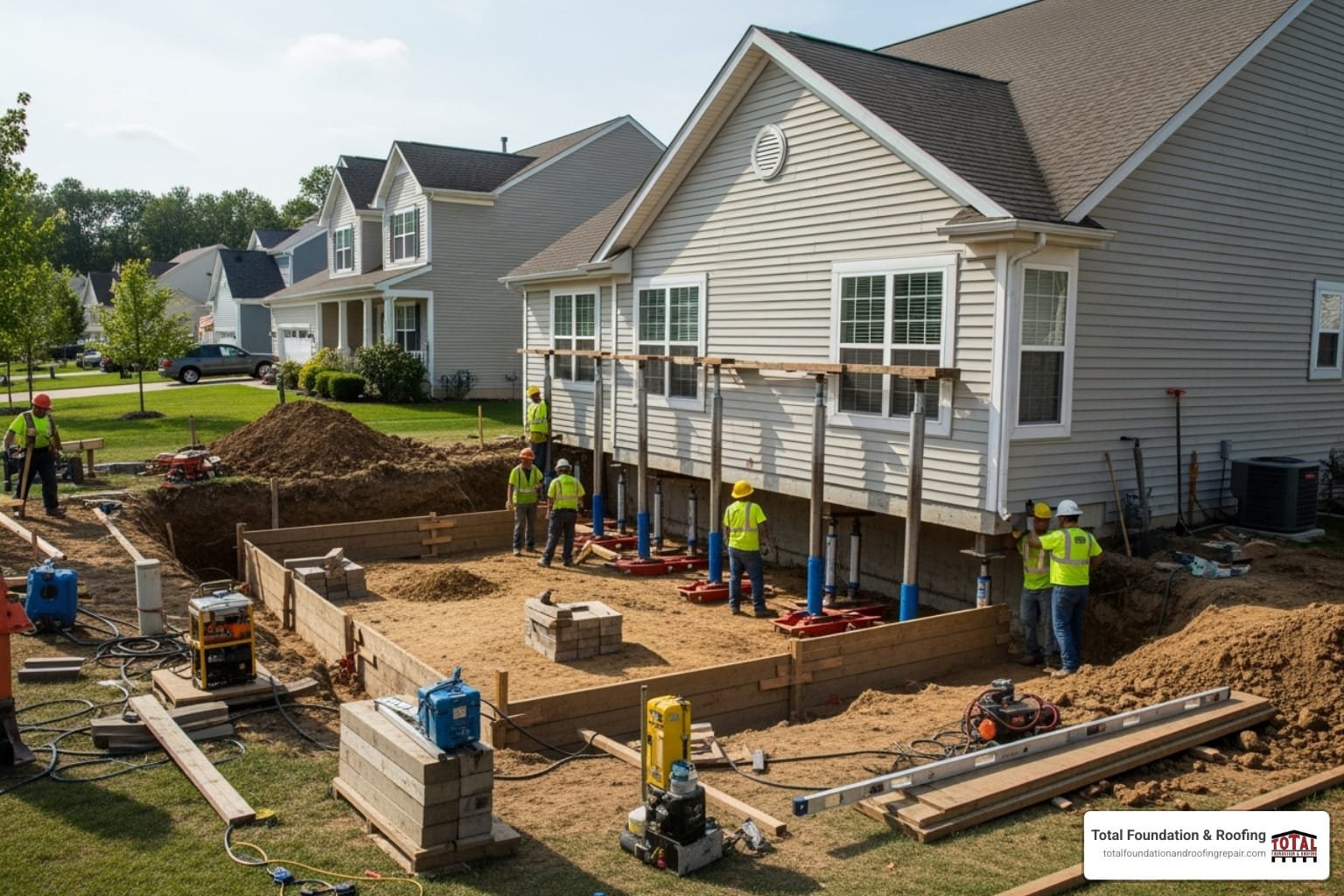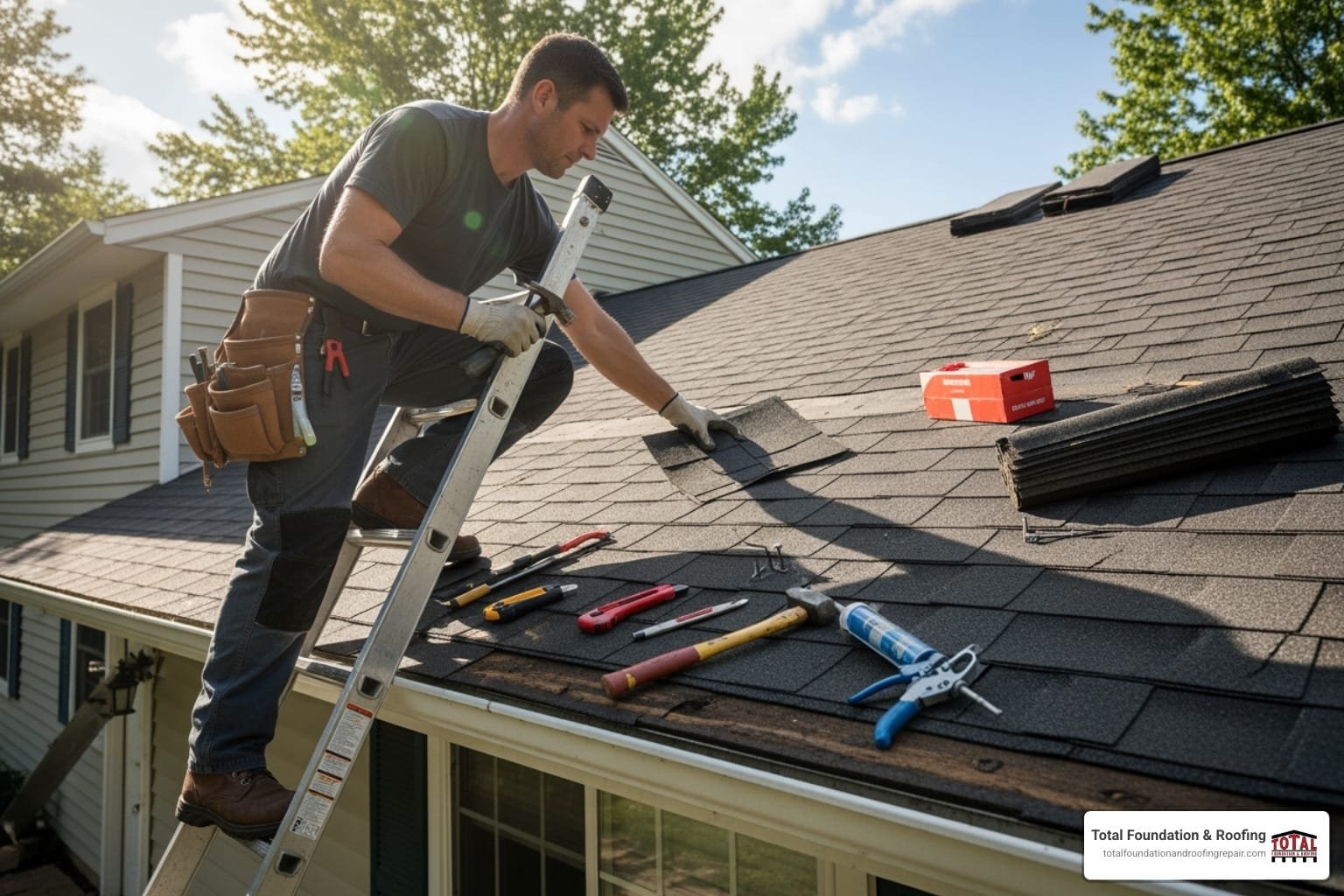Table of Contents
ToggleThe Ultimate Guide to Replacing Your Roof in Texas
Replacing your roof is one of the most significant home improvement decisions you’ll face as a Texas homeowner. Your home’s roof faces unique challenges in the Texas Hill Country, from intense summer heat and UV radiation to severe storms and hail. The average asphalt shingle roof is designed to last 20-30 years, but our demanding Texas weather can shorten that lifespan significantly. When replacement time comes, you’ll need expert roofing solutions that understand local conditions and building codes to ensure your home is protected. Knowing the signs of a failing roof and understanding the replacement process is critical to making an informed investment in your property’s safety and value.
Is It Time for a New Roof? Key Warning Signs
Knowing when it’s time for a replacement versus a simple repair can save you significant time, money, and headaches. While minor leaks or a few missing shingles might call for a repair, several tell-tale signs indicate that replacing your roof entirely is the smarter, long-term solution.

Age of Your Roof: This is one of the most straightforward indicators. Most asphalt shingle roofs last between 20 and 25 years. If your roof is approaching or has exceeded this age, it’s wise to start planning for a replacement, even if it looks okay from the ground. As materials age, they become brittle and less effective at protecting your home.
Curling, Cracking, or Missing Shingles: Look for shingles where the edges are turning upward (curling) or the middle is lifting (clawing). This warping is a clear sign of deterioration. Cracked or missing shingles are even more serious, as they expose the underlying roof structure to the elements, leading to potential leaks and water damage.
Excessive Granule Loss: Check your gutters for what looks like coarse black sand. These are the protective granules from your asphalt shingles. They shield the shingle from UV rays and add fire resistance. When they wear off, the shingle’s core is exposed, accelerating its decline.
Sagging Roof Deck or Soft Spots: A sagging roof is a serious structural concern. It often indicates widespread moisture damage to the underlying decking or even the roof trusses. If you notice a droop in the roofline or feel soft, spongy spots when walking on the roof, it’s a major red flag that requires immediate professional attention.
Leaks, Water Stains, or Attic Light: Interior damage is often the last and most urgent sign. If you’re seeing water stains on your ceilings or walls, it means water has already penetrated your roofing system. On a sunny day, go into your attic and turn off the lights. If you see any slivers of daylight coming through the roof boards, your roof’s integrity is compromised.
Storm Damage: In the Texas Hill Country, a single hailstorm or high-wind event can necessitate a full roof replacement, even on a younger roof. Hail can create bruises and cracks in shingles, while high winds can lift and break the sealant bond between them, making your roof vulnerable to future leaks.

The Roof Replacement Process: A Step-by-Step Guide
A professional roof replacement is a systematic process designed to ensure a durable, watertight result. Here are the essential steps you can expect:
Professional Assessment and Material Selection: The process begins with a thorough inspection of your entire roofing system, including the shingles, flashing, vents, and attic space. A reputable contractor will provide a detailed quote outlining the scope of work, materials to be used, and total cost. This is also when you’ll select your new roofing material and color.
Tear-Off of Old Roofing Materials: The existing layers of shingles and underlayment are stripped off down to the wooden roof deck. During this phase, your contractor should take care to protect your home’s siding, windows, and landscaping with tarps.
Decking Inspection and Repair: With the old roof removed, the contractor can perform a critical inspection of the roof deck (the plywood or OSB sheathing). They will check for any soft, rotted, or water-damaged wood that needs to be replaced to provide a solid foundation for the new roof.
Installation of the New Roofing System: This is the core of the project. It starts with installing a drip edge along the eaves, followed by an ice and water shield in vulnerable areas like valleys and around penetrations. Next, a layer of underlayment (roofing felt or synthetic) is installed over the entire deck. Finally, the new shingles or metal panels are installed, starting from the bottom and working up, along with new flashing, vents, and ridge caps.
Final Cleanup and Inspection: Once the installation is complete, the crew will conduct a thorough cleanup of the site, including using magnetic rollers to pick up stray nails from your yard and driveway. A final inspection is then performed, often with the homeowner, to ensure the job meets all standards and you are completely satisfied.
Understanding the Costs of Replacing Your Roof
When planning for replacing your roof, understanding the associated costs is paramount. The total expense can vary significantly based on the size and pitch of your roof, the materials you choose, and local labor rates. You can find more info about the cost to redo a roof on our blog.
Nationally, a full roof replacement typically costs between $6,500 and $20,000. While a partial repair is less expensive upfront, multiple repairs over time can often exceed the cost of a single, comprehensive replacement. It’s also important to understand what your insurance policy covers when deciding between repair and replacement, especially after storm damage.
Here’s a general comparison of common roofing materials, highlighting their cost, lifespan, and suitability for the Texas climate:
| Material Type | Typical Cost (per sq ft) | Average Lifespan in Texas | Pros & Cons |
|---|---|---|---|
| Asphalt Shingles | $3.50 – $7.00 | 15-25 years | Pros: Cost-effective, wide variety of styles and colors, easy to install. Architectural shingles offer enhanced durability. Cons: Shorter lifespan in harsh climates, susceptible to hail and high wind damage. |
| Metal Roofing | $8.00 – $16.00+ | 50+ years | Pros: Extremely durable, long-lasting, energy-efficient (reflects solar heat), highly resistant to fire, hail, and wind. Cons: Higher initial investment, can be noisy during rain without proper insulation. |
| Clay/Concrete Tile | $10.00 – $20.00+ | 50-100+ years | Pros: Excellent durability, Class A fire rating, superior insulation for hot climates, classic aesthetic. Cons: Very heavy (may require structural reinforcement), higher cost, can break if walked on improperly. |
I’m Daniel Sowell, owner of Total Foundation & Roofing Repair with over 18 years of experience in the Texas Hill Country. Throughout my career, I’ve guided countless homeowners through the process of replacing your roof, ensuring they get maximum value and protection for their investment. A new roof is a vital shield for your home, and choosing the right materials and a skilled, local contractor is the best way to protect that investment for decades to come.
Relevant articles related to replacing your roof:
The Ultimate Guide to Replacing Your Roof
This section will walk you through the critical stages of a roof replacement, from identifying the need to understanding the full scope of the project.
Is It Time for a New Roof? Key Warning Signs
When it comes to your home’s roof, knowing when it’s time for a replacement versus a simple repair can save you significant time, money, and headaches down the line. While minor leaks or a few missing shingles might call for a repair, several tell-tale signs indicate that replacing your roof entirely is the smarter, long-term solution.

One of the most straightforward indicators is the age of your roof. Most asphalt shingle roofs are designed to last between 20 and 25 years. If your roof is approaching or has exceeded this age, even if it looks okay from the ground, it’s wise to consider a replacement. Materials like wood shake typically last around 30 years, while more durable options can exceed 50 years. As roofs age, they become more susceptible to damage and less effective at protecting your home.
Beyond age, visible signs of wear and tear are crucial. Look for curling or clawing shingles, where the edges begin to turn upward (curling) or the middle starts to lift (clawing). This warping is a clear sign that the shingles are deteriorating and losing their effectiveness. Similarly, cracked or missing shingles expose the underlying roof structure to the elements, leading to potential leaks and further damage. If your roof resembles a “patchwork quilt” due to numerous mismatched replacement shingles, it’s a strong sign a full replacement is needed.
Another common sign of shingle degradation is finding excessive shingle granules in your gutters. These granules are the protective top layer of asphalt shingles. As they wear off, the shingles become more vulnerable to UV radiation and weather, significantly reducing their lifespan.
A sagging roof deck is a serious structural concern. This often indicates widespread water damage to the underlying decking or framing, which can lead to significant structural problems if left unaddressed. If you notice soft spots when walking on your roof, it’s a major red flag indicating extensive water damage.
Leaks are often the most urgent sign. If you’re experiencing leaks or water stains on your ceilings or walls, it means water has already penetrated your roofing system. While a single leak might be repairable, widespread or recurring leaks usually point to systemic failure and the need for a full replacement.
Finally, take a flashlight and venture into your attic on a sunny day. If you see light coming in through the roof boards, it’s a clear indication that your roof’s integrity is compromised. This also means that rain, cold air, and even unwanted houseguests like squirrels or raccoons can find their way into your home.
In the Texas Hill Country, storm damage from high winds, hail, and heavy rains can also necessitate a full roof replacement, even on a younger roof. Our climate’s extreme weather conditions put immense stress on roofing materials, shortening their lifespan. If your roof has endured a significant storm, a professional inspection is highly recommended to assess for hidden damage.
Understanding the Costs of Replacing Your Roof
When planning for replacing your roof, understanding the associated costs is paramount. The total expense can vary significantly based on several factors, including the size and pitch of your roof, the materials you choose, labor rates, and additional fees. You can find more info about the cost to redo a roof on our blog.
Nationally, replacing a typical roof using asphalt shingles costs between $3 and $6 per square foot. For architectural shingles or more specialized materials like slate, the cost can range from $4 to $11 per square foot. A full roof replacement typically costs between $5,848 and $12,879, whereas a roof repair averages between $382 and $1,829. While a partial repair is much less expensive upfront, multiple repairs over time can often exceed the cost of a single, comprehensive replacement. Sometimes, a partial replacement’s cost per square foot can even be higher than a full replacement due to fixed expenses like debris removal and permits. It’s also important to understand what your insurance policy covers when deciding between repair and replacement, especially after storm damage.
Here’s a general comparison of common roofing materials, highlighting their cost, lifespan, and suitability for the Texas climate:
| Material Type | Typical Cost (per sq ft) | Average Lifespan in Texas | Pros & Cons |
|---|---|---|---|
| Asphalt Shingles | $3.50 – $7.00 | 15-25 years | Pros: Cost-effective, wide variety of styles and colors, easy to install. Cons: Shorter lifespan, susceptible to hail and high wind damage. |
| Metal Roofing | $8.00 – $16.00+ | 50+ years | Pros: Extremely durable, long-lasting, energy-efficient, resistant to fire, hail, and wind. Cons: Higher initial investment, can be noisy during rain without proper insulation. |




